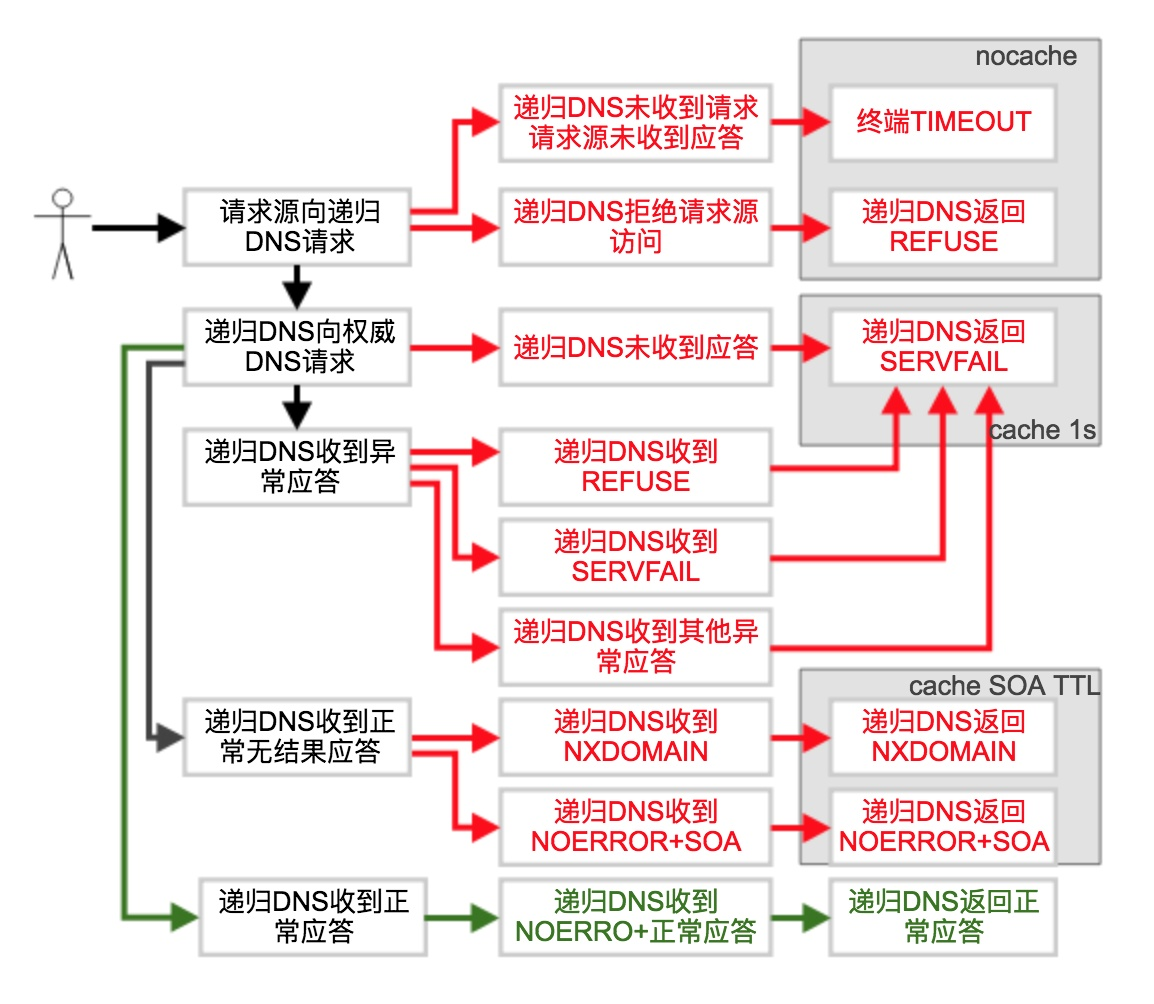BIND 主从配置
BIND 主从配置
环境:
master:172.31.182.144
slave:172.31.182.147
一、安装
yum install bind bind-chroot -y
(源码包:https://downloads.isc.org/isc/bind9/9.14.8/bind-9.14.8.tar.gz)
二、master配置
1 2 3 4 5 6 7 8 9 10 11 12 13 14 15 16 17 18 19 20 21 22 23 24 25 26 27 28 29 30 31 32 33 34 35 36 37 38 39 40 41 42 43 44 45 46 47 48 | [root@master named]# cat /etc/named.conf |grep -Ev "//|^$"options { listen-on port 53 { 172.31.182.144; }; listen-on-v6 port 53 { ::1; }; directory "/var/named"; dump-file "/var/named/data/cache_dump.db"; statistics-file "/var/named/data/named_stats.txt"; memstatistics-file "/var/named/data/named_mem_stats.txt"; recursing-file "/var/named/data/named.recursing"; secroots-file "/var/named/data/named.secroots"; /* - If you are building an AUTHORITATIVE DNS server, do NOT enable recursion. - If you are building a RECURSIVE (caching) DNS server, you need to enable recursion. - If your recursive DNS server has a public IP address, you MUST enable access control to limit queries to your legitimate users. Failing to do so will cause your server to become part of large scale DNS amplification attacks. Implementing BCP38 within your network would greatly reduce such attack surface */ recursion yes; dnssec-enable yes; dnssec-validation yes; /* Path to ISC DLV key */ bindkeys-file "/etc/named.iscdlv.key"; managed-keys-directory "/var/named/dynamic"; pid-file "/run/named/named.pid"; session-keyfile "/run/named/session.key";};logging { channel default_debug { file "data/named.run"; severity dynamic; };};zone "adfile.wifi8.com" { type master; file "adfile.wifi8.com.hosts"; allow-transfer {172.31.182.147;}; notify yes; also-notify { 172.31.182.147; }; //指定slave server的IP位址 };zone "." IN { type hint; file "named.ca";};include "/etc/named.rfc1912.zones";include "/etc/named.root.key"; |
zone文件:
1 2 3 4 5 6 7 8 9 10 11 12 13 14 | [root@master named]# cat /var/named/adfile.wifi8.com.hosts$TTL 180@ IN SOA ns1.test.com. root.adfile.wifi8.com. ( ; 22190928 ; serial 10S ; refresh 1H ; retry 1M ; expire 44H ) ; minimum IN NS ns1.test.com. IN NS ns2.test.com.ns1 IN A 172.31.182.144ns2 IN A 172.31.182.147adfile.wifi8.com. IN A 10.254.33.32adfile.wifi8.com. IN A 10.254.33.34 |
各参数解析:http://dns-learning.twnic.net.tw/bind/intro6.html
启动:
systemctl restart named.service
三、slave配置
1 2 3 4 5 6 7 8 9 10 11 12 13 14 15 16 17 18 19 20 21 22 23 24 25 26 27 28 29 30 31 32 33 34 35 36 37 38 39 40 41 42 43 44 45 46 | [root@node02 named]# cat /etc/named.conf |grep -Ev "//|^$"options { listen-on port 53 { 172.31.182.147; }; listen-on-v6 port 53 { ::1; }; directory "/var/named"; dump-file "/var/named/data/cache_dump.db"; statistics-file "/var/named/data/named_stats.txt"; memstatistics-file "/var/named/data/named_mem_stats.txt"; recursing-file "/var/named/data/named.recursing"; secroots-file "/var/named/data/named.secroots"; /* - If you are building an AUTHORITATIVE DNS server, do NOT enable recursion. - If you are building a RECURSIVE (caching) DNS server, you need to enable recursion. - If your recursive DNS server has a public IP address, you MUST enable access control to limit queries to your legitimate users. Failing to do so will cause your server to become part of large scale DNS amplification attacks. Implementing BCP38 within your network would greatly reduce such attack surface */ recursion yes; dnssec-enable yes; dnssec-validation yes; /* Path to ISC DLV key */ bindkeys-file "/etc/named.iscdlv.key"; managed-keys-directory "/var/named/dynamic"; pid-file "/run/named/named.pid"; session-keyfile "/run/named/session.key";};logging { channel default_debug { file "data/named.run"; severity dynamic; };};zone "adfile.wifi8.com" { type slave; file "adfile.wifi8.com.hosts"; masters { 172.31.182.144; }; };zone "." IN { type hint; file "named.ca";};include "/etc/named.rfc1912.zones";include "/etc/named.root.key"; |
启动后自动同步master解析配置:
systemctl restart named.service
添加域名脚本:
1 2 3 4 5 6 7 8 9 10 11 12 13 14 15 16 17 18 19 20 21 22 23 24 25 26 27 28 29 30 31 32 33 34 35 36 37 38 39 40 41 42 43 44 45 46 47 48 49 50 51 52 53 54 55 56 57 58 59 60 61 62 | #################master:##################!/bin/bashread -p "Please enter the domain name you need to add:" DOMAINread -p "Please enter the domain name corresponding to the IP record:" IPHOSTS_DIR=/mnt/sscp/data/named/hostsNAMED_CONFIG_DIR=/mnt/sscp/data/named/conf/named.conf#Create domain record filecat >${HOSTS_DIR}/${DOMAIN}.hosts<<EOF\$TTL 180@ IN SOA ns1.sscp.mtr.com. root.${DOMAIN}. ( ; 0 ; serial 1D ; refresh 1H ; retry 1W ; expire 44H ) ; minimum IN NS ns1.sscp.mtr.com. IN NS ns2.sscp.mtr.com.ns1 IN A 128.164.250.26ns2 IN A 128.164.250.27${DOMAIN}. IN A ${IP}EOF#Add named configcat >>${NAMED_CONFIG_DIR}<<EOFzone "${DOMAIN}" IN{ type master; file "${DOMAIN}.hosts"; allow-transfer {128.164.250.27;};};EOF# Checkconf named config/mnt/sscp/app/named/sbin/named-checkconf#Restart named server/mnt/sscp/app/named/sbin/rndc -s 127.0.0.1 reloadif [ $? = 0 ];then echo "Added successfully!!"else echo "Add failed!! Please check"fi#################slave:##################!/bin/bashread -p "Please enter the domain name you need to add:" DOMAINHOSTS_DIR=/mnt/sscp/data/named/hostsNAMED_CONFIG_DIR=/mnt/sscp/data/named/conf/named.conf#Add named configcat >>${NAMED_CONFIG_DIR}<<EOFzone "${DOMAIN}" IN{ type slave; file "${DOMAIN}.hosts"; masters { 128.164.250.26; };};EOF# Checkconf named config/mnt/sscp/app/named/sbin/named-checkconf#Restart named server/mnt/sscp/app/named/sbin/rndc -s 127.0.0.1 reloadif [ $? = 0 ];then echo "Added successfully!!"else echo "Add failed!! Please check"fi |
踩坑:
1、最后需要在主DNS服务器上的/var/named/ZONE_NAME.zone 文件里添加将该从服务的NS记录;
2、同时若想要实现主从服务器的数据同步,在修改好主服务器的/var/named/ZONE_NAME.zone 文件时,必须将该文件里的 序列号 增大才行,增大并保存退出后,主服务器会自动向从服务器推送(push)修改后的文件内容;

如对您有帮助,支持下呗!
微信

支付宝





【推荐】国内首个AI IDE,深度理解中文开发场景,立即下载体验Trae
【推荐】编程新体验,更懂你的AI,立即体验豆包MarsCode编程助手
【推荐】抖音旗下AI助手豆包,你的智能百科全书,全免费不限次数
【推荐】轻量又高性能的 SSH 工具 IShell:AI 加持,快人一步
· .NET Core 中如何实现缓存的预热?
· 从 HTTP 原因短语缺失研究 HTTP/2 和 HTTP/3 的设计差异
· AI与.NET技术实操系列:向量存储与相似性搜索在 .NET 中的实现
· 基于Microsoft.Extensions.AI核心库实现RAG应用
· Linux系列:如何用heaptrack跟踪.NET程序的非托管内存泄露
· TypeScript + Deepseek 打造卜卦网站:技术与玄学的结合
· 阿里巴巴 QwQ-32B真的超越了 DeepSeek R-1吗?
· 【译】Visual Studio 中新的强大生产力特性
· 【设计模式】告别冗长if-else语句:使用策略模式优化代码结构
· AI与.NET技术实操系列(六):基于图像分类模型对图像进行分类